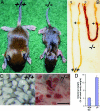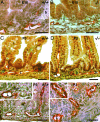Postnatal lymphatic partitioning from the blood vasculature in the small intestine requires fasting-induced adipose factor
- PMID: 17202268
- PMCID: PMC1761863
- DOI: 10.1073/pnas.0605957104
Postnatal lymphatic partitioning from the blood vasculature in the small intestine requires fasting-induced adipose factor
Abstract
Lymphatic vessels develop from specialized venous endothelial cells. Using knockout mice, we found that fasting-induced adipose factor (Fiaf) is required for functional partitioning of postnatal intestinal lymphatic and blood vessels. In wild-type animals, levels of intestinal Fiaf expression rise during the first postnatal day and peak at day 2, which coincides with the onset of the lymphatico-venous partitioning abnormality in Fiaf-/- mutants on a mixed 129/SvJ:C57BL/6 genetic background. Fiaf deficiency is not associated with disruption of the blood vasculature or with lymphatic endothelial recruitment of smooth muscle cells. We identified Prox1, a critical regulator of lymphangiogenesis, as a downstream target for Fiaf signaling in the intestinal lymphatic endothelium. This organ-specific lymphovascular abnormality can be rescued by allowing embryonic Fiaf-/- intestinal isografts to develop in Fiaf+/+ recipients.
Conflict of interest statement
The authors declare no conflict of interest.
Figures





References
-
- Wigle JT, Oliver G. Cell. 1999;98:769–778. - PubMed
-
- Karkkainen MJ, Haiko P, Sainio K, Partanen J, Taipale J, Petrova TV, Jeltsch M, Jackson DG, Talikka M, Rauvala H, et al. Nat Immunol. 2004;5:74–80. - PubMed
-
- Dumont DJ, Jussila L, Taipale J, Lymboussaki A, Mustonen T, Pajusola K, Breitman M, Alitalo K. Science. 1998;282:946–949. - PubMed
-
- Karkkainen MJ, Ferrell RE, Lawrence EC, Kimak MA, Levinson KL, McTigue MA, Alitalo K, Finegold DN. Nat Genet. 2000;25:153–159. - PubMed
Publication types
MeSH terms
Substances
Grants and funding
LinkOut - more resources
Full Text Sources
Molecular Biology Databases

